Challenges and Opportunities for Recycled Polyethylene Fishing Nets: Towards a Circular Economy
Abstract
:1. Introduction
2. Materials and Methods
2.1. Materials
2.2. Molecular and Physical Characterization
2.3. Environmental Stress Crack Resistance (ESCR)
3. Results and Discussion
3.1. Blends for Fishing Nets Gear Application
3.2. Blends for Packaging Application
4. Conclusions
Author Contributions
Funding
Institutional Review Board Statement
Informed Consent Statement
Data Availability Statement
Acknowledgments
Conflicts of Interest
References
- PlasticsEurope Plastics—the Facts 2020. Available online: https://www.plasticseurope.org/es/resources/publications/4312-plastics-facts-2020 (accessed on 12 January 2021).
- Barnes, D.K.A.; Galgani, F.; Thompson, R.C.; Barlaz, M. Accumulation and fragmentation of plastic debris in global environments. Philos. Trans. R. Soc. B-Biol. Sci. 2009, 364, 1985–1998. [Google Scholar] [CrossRef] [PubMed] [Green Version]
- Lebreton, L.; Slat, B.; Ferrari, F.; Sainte-Rose, B.; Aitken, J.; Marthouse, R.; Hajbane, S.; Cunsolo, S.; Schwarz, A.; Levivier, A.; et al. Evidence that the Great Pacific Garbage Patch is rapidly accumulating plastic. Sci. Rep. 2018, 8, 4666. [Google Scholar] [CrossRef] [PubMed] [Green Version]
- Peng, L.; Fu, D.; Qi, H.; Lan, C.Q.; Yu, H.; Ge, C. Micro- and nano-plastics in marine environment: Source, distribution and threats—A review. Sci. Total Environ. 2020, 698. [Google Scholar] [CrossRef] [PubMed]
- Lau, W.W.Y.; Shiran, Y.; Bailey, R.M.; Cook, E.; Stuchtey, M.R.; Koskella, J.; Velis, C.A.; Godfrey, L.; Boucher, J.; Murphy, M.B.; et al. Evaluating scenarios toward zero plastic pollution. Sci. 2020, 369, 1455–1461. [Google Scholar] [CrossRef]
- Sherrington, C. Plastics in the Marine Environment; Eunomia Research & Consulting Ltd.: Bristol, UK, 2016. [Google Scholar]
- Jambeck, J.; Hardesty, B.D.; Brooks, A.L.; Friend, T.; Teleki, K.; Fabres, J.; Beaudoin, Y.; Bamba, A.; Francis, J.; Ribbink, A.J.; et al. Challenges and emerging solutions to the land-based plastic waste issue in Africa. Mar. Policy 2018, 96, 256–263. [Google Scholar] [CrossRef]
- Wichai-utcha, N.; Chavalparit, O. 3Rs Policy and plastic waste management in Thailand. J. Mater. Cycles Waste Manag. 2019, 21, 10–22. [Google Scholar] [CrossRef]
- Georg, H.; Dennis, W.; Willem, V.; Anna, A.; Alberto, B.; María, D.C.M.; Eugenia, M.J.M.; Vinci, M.; Giorgetti, A. EU Marine Beach Litter Baselines 2019. Available online: https://mcc.jrc.ec.europa.eu/main/dev.py?N=41&O=452 (accessed on 29 July 2021).
- Macfadyen, G.; Huntington, T.; Cappell, R. Abandoned, Lost or Otherwise Discarded Fishing Gear; UNEP/FAO, Ed.; UNEP/FAO: Lymington, UK, 2009; ISBN 978-92-5-106196-1. [Google Scholar]
- Richardson, K.; Wilcox, C.; Vince, J.; Hardesty, B.D. Challenges and misperceptions around global fishing gear loss estimates. Mar. Policy 2021, 129, 104522. [Google Scholar] [CrossRef]
- De Sa, L.C.; Oliveira, M.; Ribeiro, F.; Rocha, T.L.; Futter, M.N. Studies of the effects of microplastics on aquatic organisms: What do we know and where should we focus our efforts in the future? Sci. Total Environ. 2018, 645, 1029–1039. [Google Scholar] [CrossRef]
- Wright, S.L.; Thompson, R.C.; Galloway, T.S. The physical impacts of microplastics on marine organisms: A review. Environ. Pollut. 2013, 178, 483–492. [Google Scholar] [CrossRef]
- Beaumont, N.J.; Aanesen, M.; Austen, M.C.; Borger, T.; Clark, J.R.; Cole, M.; Hooper, T.; Lindeque, P.K.; Pasco, C.; Wyles, K.J. Global ecological, social and economic impacts of marine plastic. Mar. Pollut. Bull. 2019, 142, 189–195. [Google Scholar] [CrossRef]
- Xanthos, D.; Walker, T.R. International policies to reduce plastic marine pollution from single-use plastics (plastic bags and microbeads): A review. Mar. Pollut. Bull. 2017, 118, 17–26. [Google Scholar] [CrossRef] [PubMed]
- Pinto da Costa, J.; Rocha-Santos, T.; Duarte, A.C. The Environmental Impacts of Plastics and Micro-Plastics Use, Waste and Pollution: EU and National Measures; European Union: Brussels, Belgium, 2020.
- Li, W.C.; Tse, H.F.; Fok, L. Plastic waste in the marine environment: A review of sources, occurrence and effects. Sci. Total Environ. 2016, 566, 333–349. [Google Scholar] [CrossRef] [PubMed]
- Mondragon, G.; Kortaberria, G.; Mendiburu Valor, E.; González, N.; Arbelaiz, A.; Peña, C. Thermomechanical recycling of polyamide 6 from fishing nets waste. J. Appl. Polym. Sci. 2019, 137, 48442. [Google Scholar] [CrossRef]
- Mihut, C.; Captain, D.K.; Gadala-Maria, F.; Amiridis, M.D. Review: Recycling of nylon from carpet waste. Polym. Eng. Sci. 2001, 41, 1457–1470. [Google Scholar] [CrossRef]
- Charter, M.; Soren, J.; Carruthers, R. Products from Waste Fishing Nets; The Centre for Sustainable Design: Farnham, UK, 2018. [Google Scholar]
- Coe, J.M.; Bunn, A.R. National Oceanic and Atmospheric Administration Research on the Use of Degradable Fishing Gear and Packaging Materials; Northwest and Alaska Fisheries Center: Seattle, WA, USA, 1987. [Google Scholar]
- Andrady, A.L. Microplastics in the marine environment. Mar. Pollut. Bull. 2011, 62, 1596–1605. [Google Scholar] [CrossRef]
- Feary, D.; Aranda, M.; Russell, J.; Cabezas, O.; Rodríguez Climent, S.; Bremner, J. Study on Circular Design of the Fishing Gear for Reduction of Environmental Impacts; European Commision: Brussels, Belgium, 2020. [CrossRef]
- Bertelsen, I.M.G.; Ottosen, L.M. Reuse of polyethylene fibres from discarded fishing nets as reinforcement in gypsym-based materials. Acad. J. Civ. Eng. 2017, 35, 545–548. [Google Scholar] [CrossRef]
- Sato, T.; Shishido, M. Mechanical and structural properties for recycled thermoplastics from waste fishing ropes. J. Mater. Cycles Waste Manag. 2020, 22, 1682–1689. [Google Scholar] [CrossRef]
- Truong, V.D.; Kim, M.O.; Kim, D.J. Feasibility study on use of waste fishing nets as continuous reinforcements in cement-based matrix. Constr. Build. Mater. 2021, 269, 121314. [Google Scholar] [CrossRef]
- Monteiro, D.; Rangel, B.; Alves, J.; Teixeira, A. Design as a vehicle for using waste of fishing nets and ropes to create new products. Eng. Soc. 2016, 2016, 67. [Google Scholar]
- Zylberberg, N. PLASTIX Creates New Material from Used Maritime Gear. Available online: https://medium.com/2030magazine/plastix-creates-new-material-from-ghost-nets-d9ce9ee4ca83 (accessed on 1 June 2021).
- NetPlus® Recycled Fishing Nets. Available online: https://www.patagonia.com/our-footprint/netplus-recycled-fishing-nets.html (accessed on 5 July 2021).
- Vilaplana, F.; Karlsson, S. Quality Concepts for the Improved Use of Recycled Polymeric Materials: A Review. Macromol. Mater. Eng. 2008, 293, 274–297. [Google Scholar] [CrossRef]
- Juan, R.; Domínguez, C.; Robledo, N.; Paredes, B.; García-Muñoz, R.A. Incorporation of recycled high-density polyethylene to polyethylene pipe grade resins to increase close-loop recycling and Underpin the circular economy. J. Clean. Prod. 2020, 276, 124081. [Google Scholar] [CrossRef]
- Istrate, I.-R.; Juan, R.; Martin-Gamboa, M.; Domínguez, C.; García-Muñoz, R.A.; Dufour, J. Environmental life cycle assessment of the incorporation of recycled high-density polyethylene to polyethylene pipe grade resins. J. Clean. Prod. 2021, 319, 128580. [Google Scholar] [CrossRef]
- Al-Salem, S.M.; Lettieri, P.; Baeyens, J. Recycling and recovery routes of plastic solid waste (PSW): A review. Waste Manag. 2009, 29, 2625–2643. [Google Scholar] [CrossRef]
- Welden, N.A.; Cowie, P.R. Degradation of common polymer ropes in a sublittoral marine environment. Mar. Pollut. Bull. 2017, 118, 248–253. [Google Scholar] [CrossRef] [PubMed] [Green Version]
- Gall, M.; Freudenthaler, P.; Fischer, J.; Lang, R. Characterization of Composition and Structure–Property Relationships of Commercial Post-Consumer Polyethylene and Polypropylene Recyclates. Polymers (Basel) 2021, 13, 1574. [Google Scholar] [CrossRef] [PubMed]
- Messiha, M.; Frank, A.; Koch, T.; Arbeiter, F.; Pinter, G. Effect of polyethylene and polypropylene cross-contamination on slow crack growth resistance. Int. J. Polym. Anal. Charact. 2020, 25, 649–666. [Google Scholar] [CrossRef]
- Gulmine, J.V.; Janissek, P.R.; Heise, H.M.; Akcelrud, L. Polyethylene characterization by FTIR. Polym. Test. 2002, 21, 557–563. [Google Scholar] [CrossRef]
- Schindler, A.; Doedt, M.; Gezgin, Ş.; Menzel, J.; Schmölzer, S. Identification of polymers by means of DSC, TG, STA and computer-assisted database search. J. Therm. Anal. Calorim. 2017, 129, 833–842. [Google Scholar] [CrossRef] [Green Version]
- Juan, R.; Paredes, B.; García-Muñoz, R.A.; Domínguez, C. Quantification of PP contamination in recycled PE by TREF analysis for improved the quality and circularity of plastics. Polym. Test. 2021, 100, 107273. [Google Scholar] [CrossRef]
- Fernández, A.; Expósito, M.T.; Peña, B.; Berger, R.; Shu, J.; Graf, R.; Spiess, H.W.; García-Muñoz, R.A. Molecular structure and local dynamic in impact polypropylene copolymers studied by preparative TREF, solid state NMR spectroscopy, and SFM microscopy. Polymers (Guildf) 2015, 61, 87–98. [Google Scholar] [CrossRef]
- European Union A European Strategy for Plastics in a Circular Economy. Available online: https://publications.europa.eu/s/kIT6 (accessed on 28 September 2019).
- Schyns, Z.O.G.; Shaver, M.P. Mechanical Recycling of Packaging Plastics: A Review. Macromol. Rapid Commun. 2021, 42, 2000415. [Google Scholar] [CrossRef]
- Brown, H.R. A theory of the environmental stress cracking of polyethylene. Polymers (Guildf) 1978, 19, 1186–1188. [Google Scholar] [CrossRef]
- Hittmair, P.; Ullman, R. Environmental stress cracking of polyethylene. J. Appl. Polym. Sci. 1962, 6, 1–14. [Google Scholar] [CrossRef]
- Vogt, B.D.; Stokes, K.K.; Kumar, S.K. Why is Recycling of Postconsumer Plastics so Challenging? ACS Appl. Polym. Mater. 2021, 3, 4325–4346. [Google Scholar] [CrossRef]
- Benoit, N.; González-Núñez, R.; Rodrigue, D. High Density Polyethylene Degradation Followed by Closed-loop Recycling. Prog. Rubber Plast. Recycl. Technol. 2017, 33, 17–38. [Google Scholar] [CrossRef]
- García, R.; Carrero, A.; Aroca, M.; Prieto, O.; Domínguez, C. Slow crack growth resistance in resin blends of chromium and metallocene catalyzed ethylene-hexene copolymers for pipe applications. Polym. Eng. Sci. 2008, 48, 925–933. [Google Scholar] [CrossRef]
- García, R.A.; Carrero, A.; Martín, C.; Domínguez, C. Effects of the structural components on slow crack growth process in polyethylene blends. Composition intervals prediction for pipe applications. J. Appl. Polym. Sci. 2011, 121, 3269–3276. [Google Scholar] [CrossRef]
- Adib, A.; Domínguez, C.; Rodríguez, J.; Martín, C.; García, R.A. The effect of microstructure on the slow crack growth resistance in polyethylene resins. Polym. Eng. Sci. 2015, 55, 1018–1023. [Google Scholar] [CrossRef]
- Tsenoglou, C. Molecular weight polydispersity effects on the viscoelasticity of entangled linear polymers. Macromolecules 1991, 24, 1762–1767. [Google Scholar] [CrossRef]
- Groves, D.J.; McLeish, T.C.B.; Chohan, R.K.; Coates, P.D. Predicting the rheology of linear with branched polyethylene blends. Rheol. Acta 1996, 35, 481–491. [Google Scholar] [CrossRef]
- Robledo, N.; Vega, J.F.; Nieto, J.; Martínez-Salazar, J. The role of the interface in melt linear viscoelastic properties of LLDPE/LDPE blends: Effect of the molecular architecture of the matrix. J. Appl. Polym. Sci. 2009, 114, 420–429. [Google Scholar] [CrossRef]
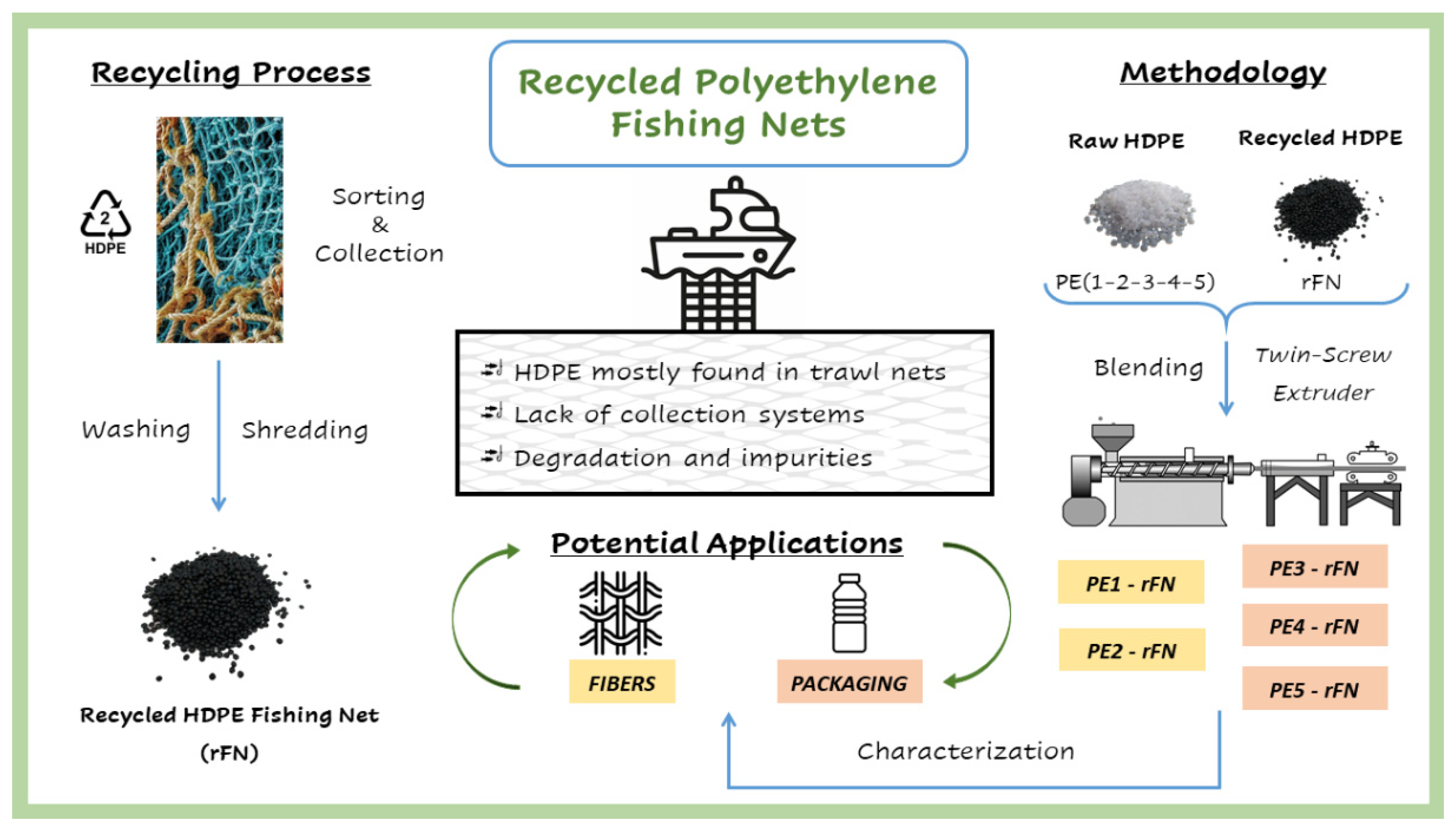
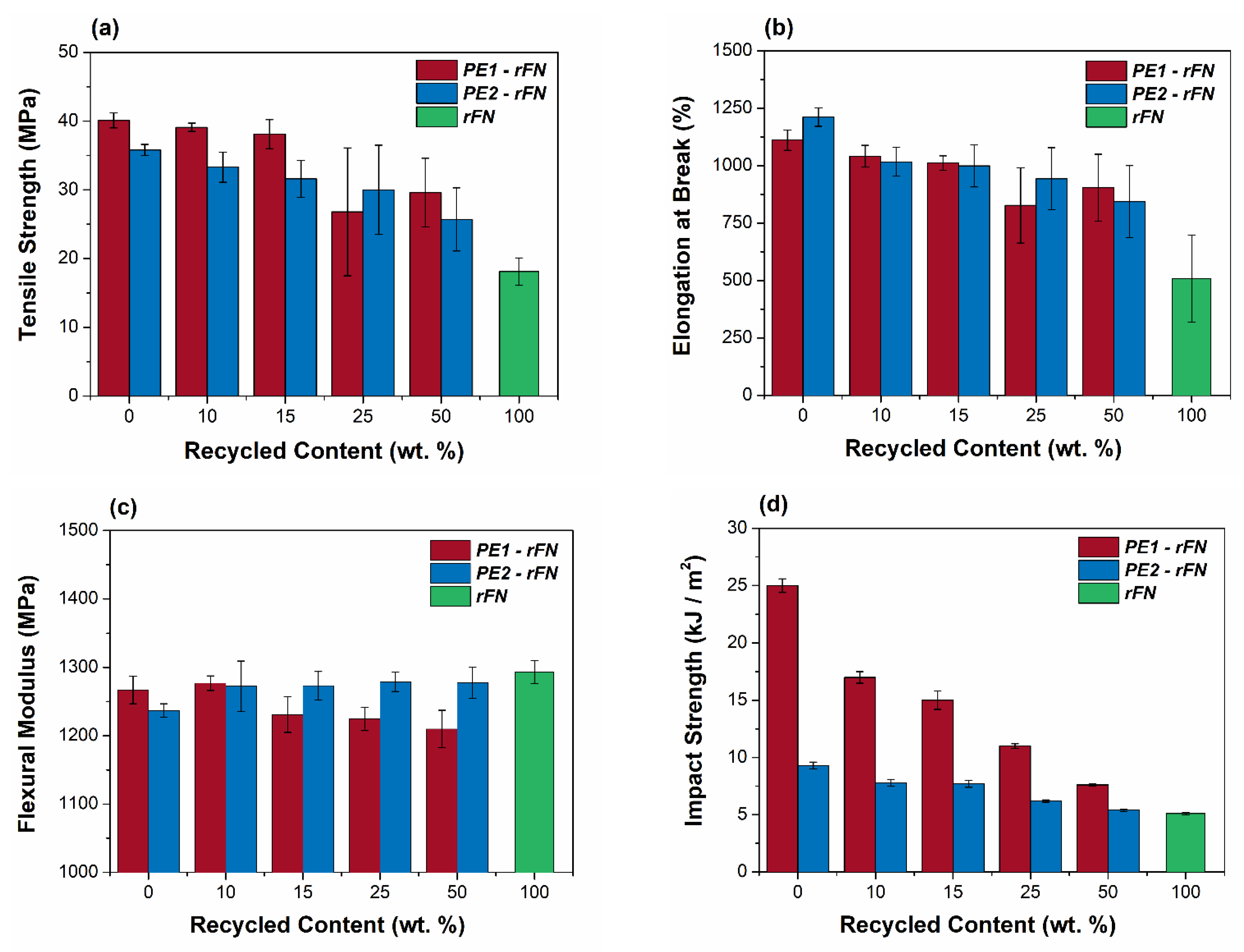
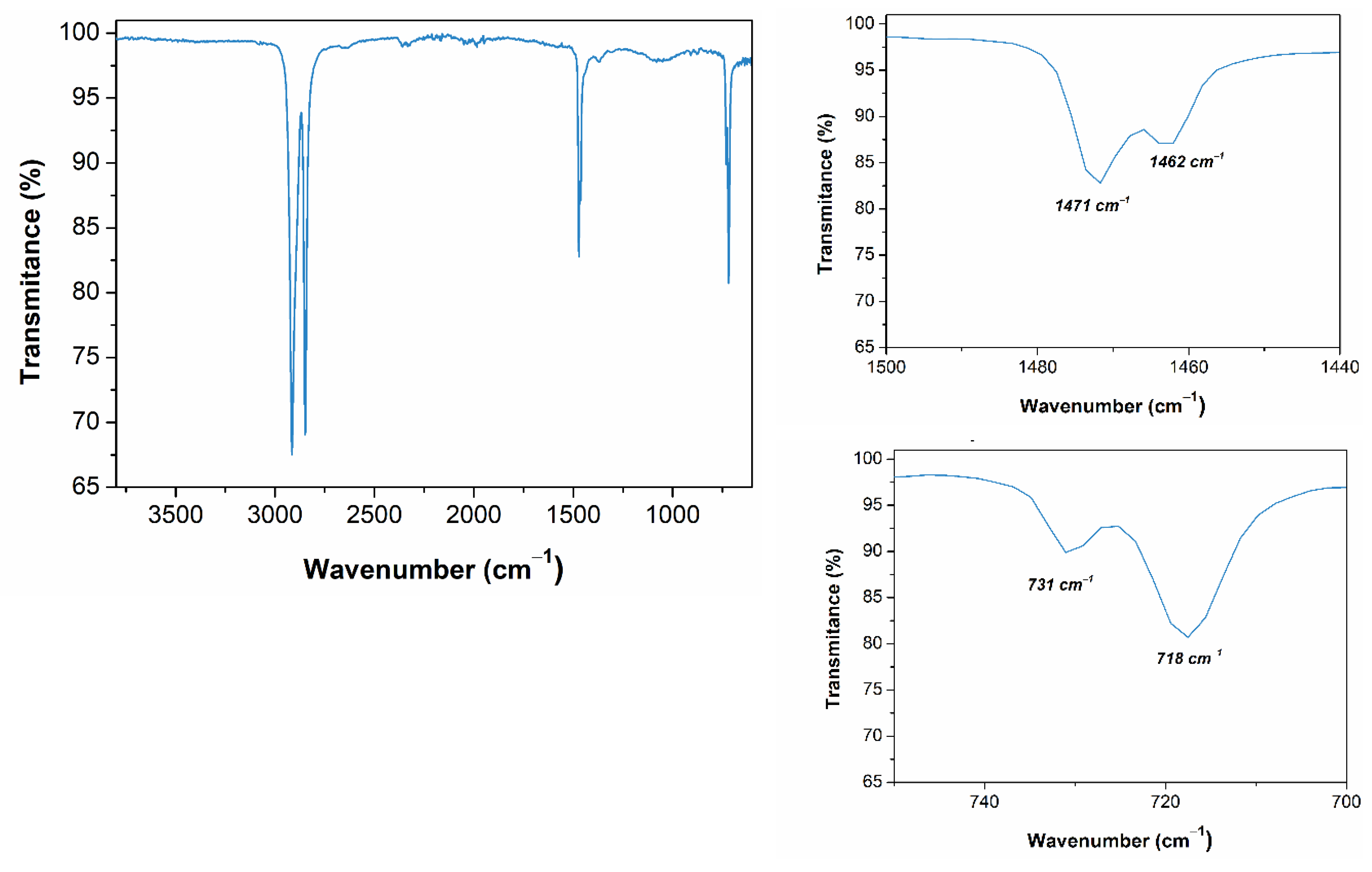
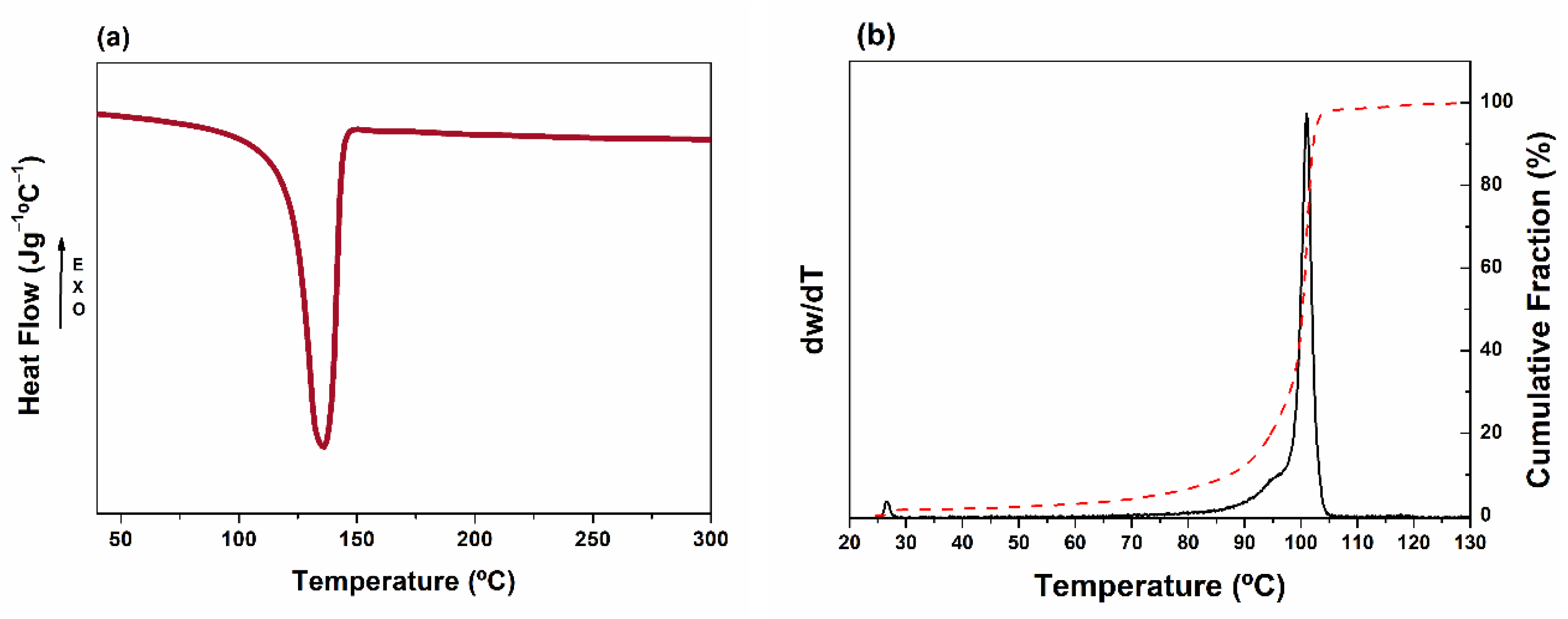
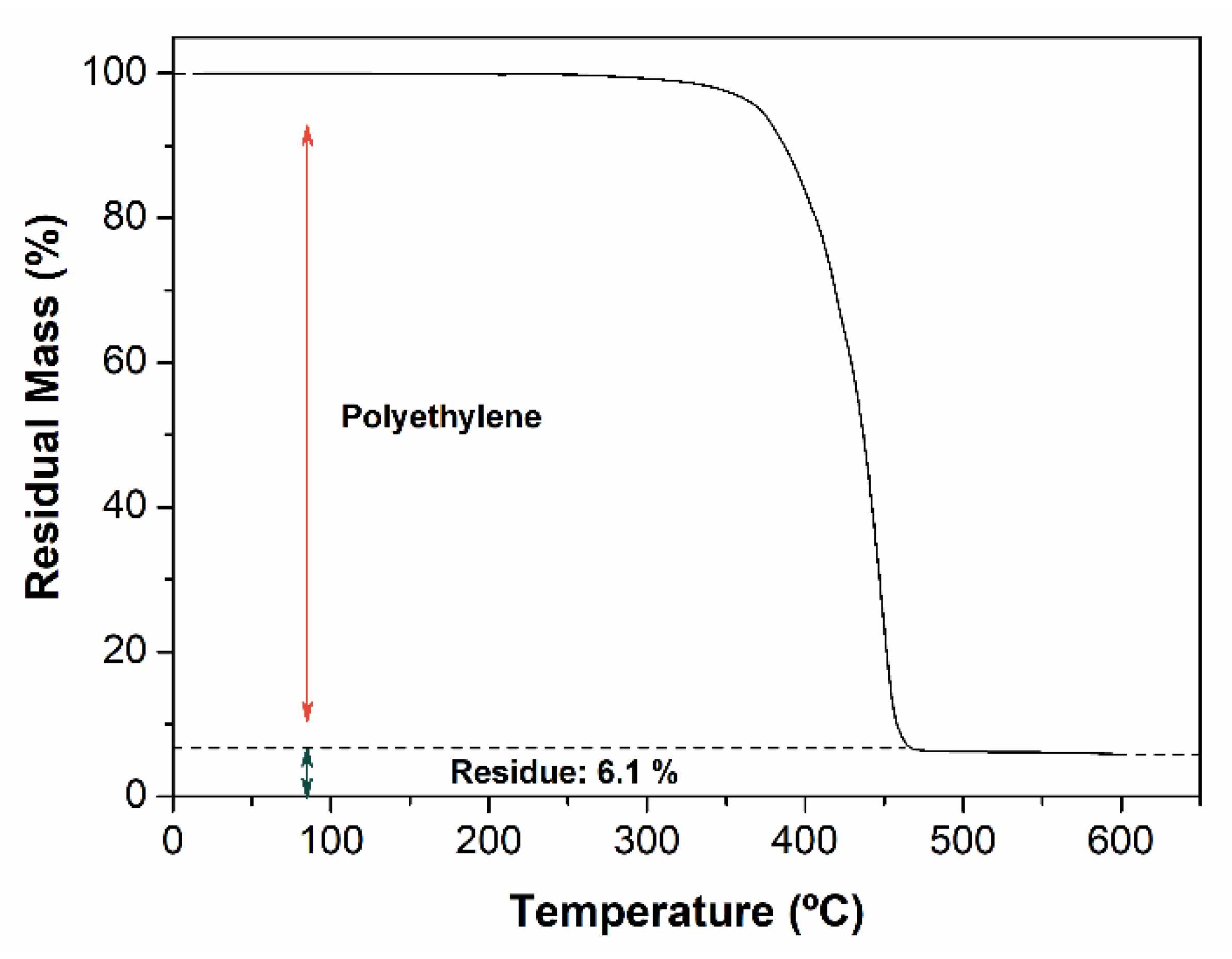
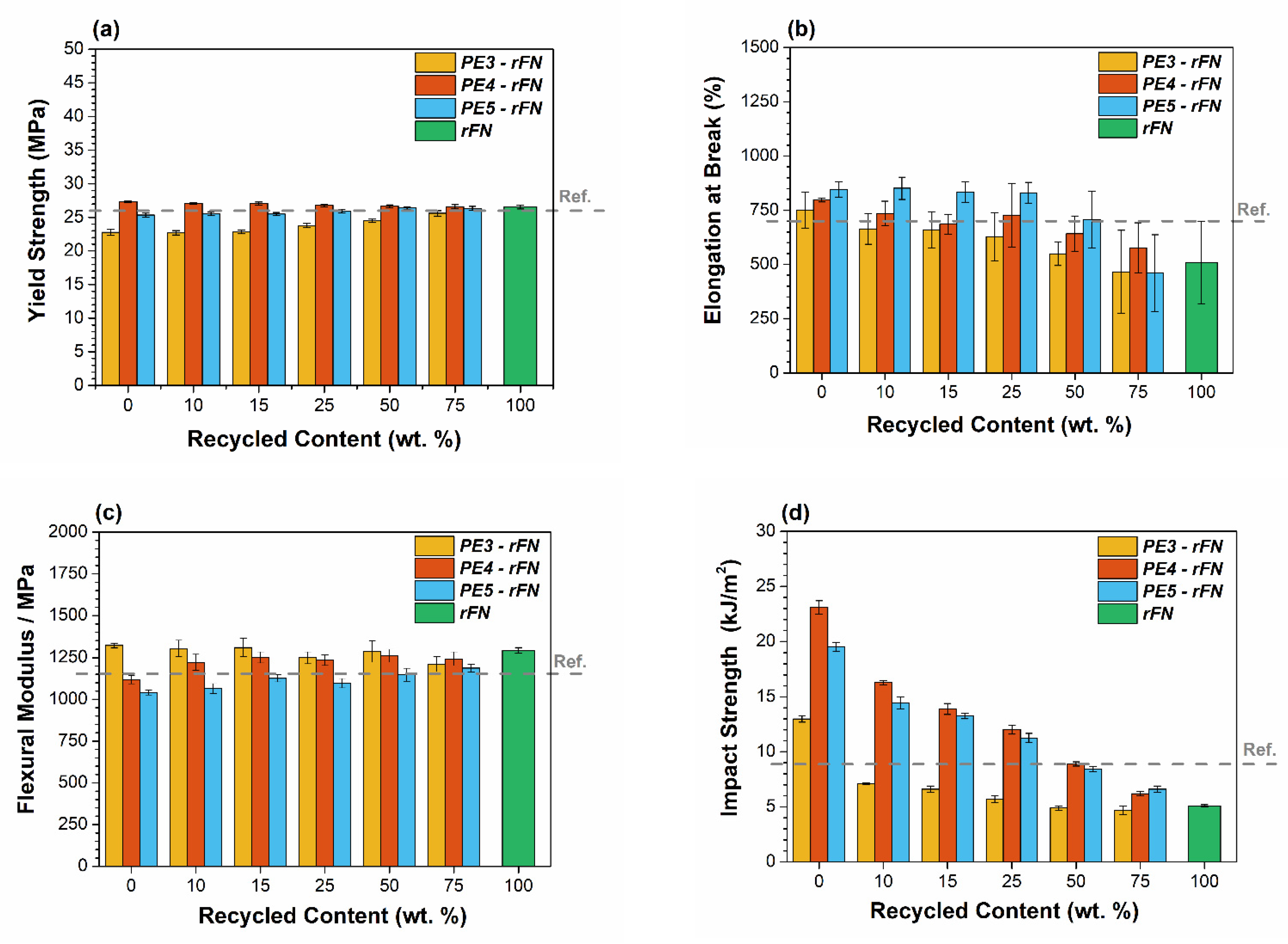
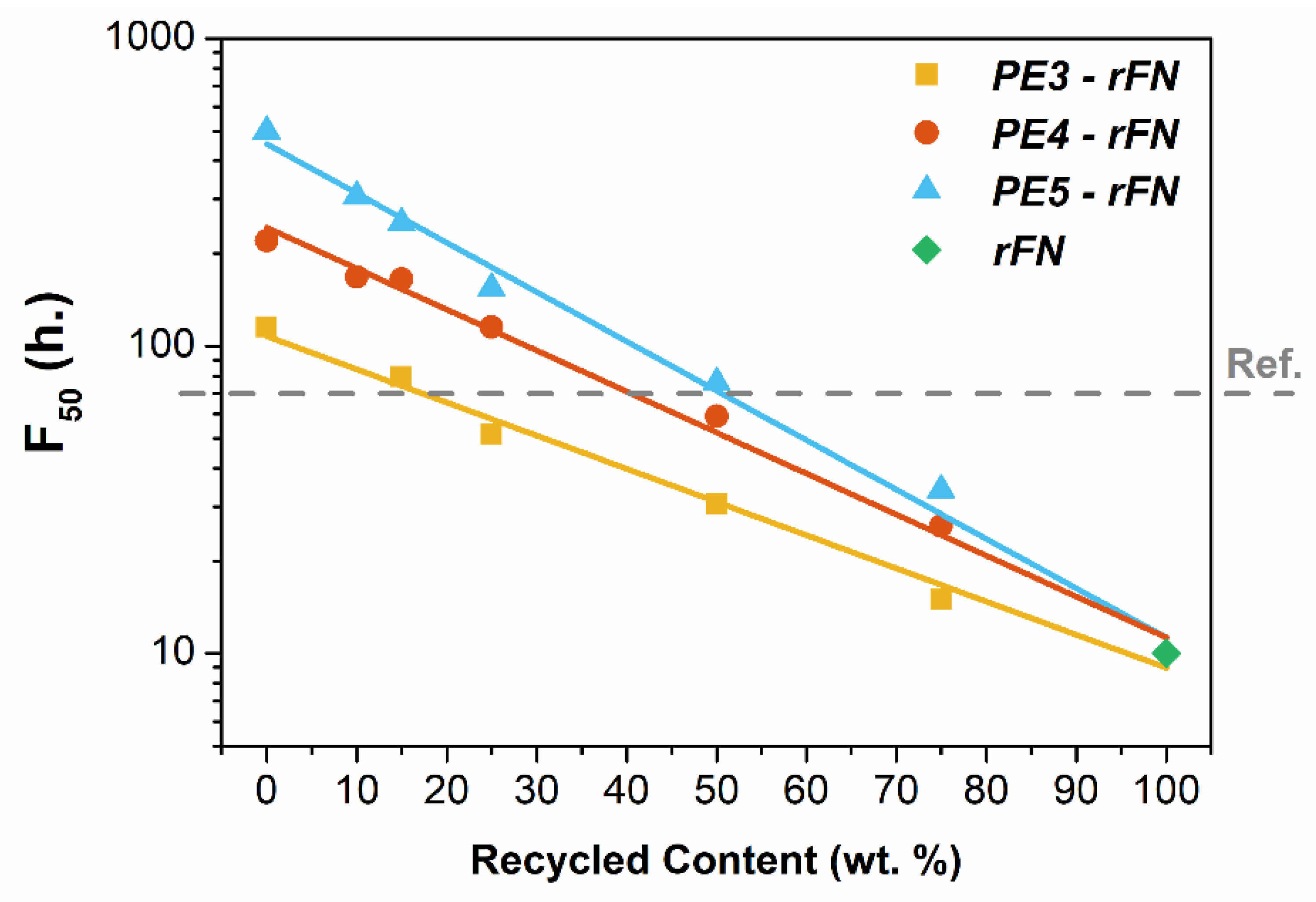
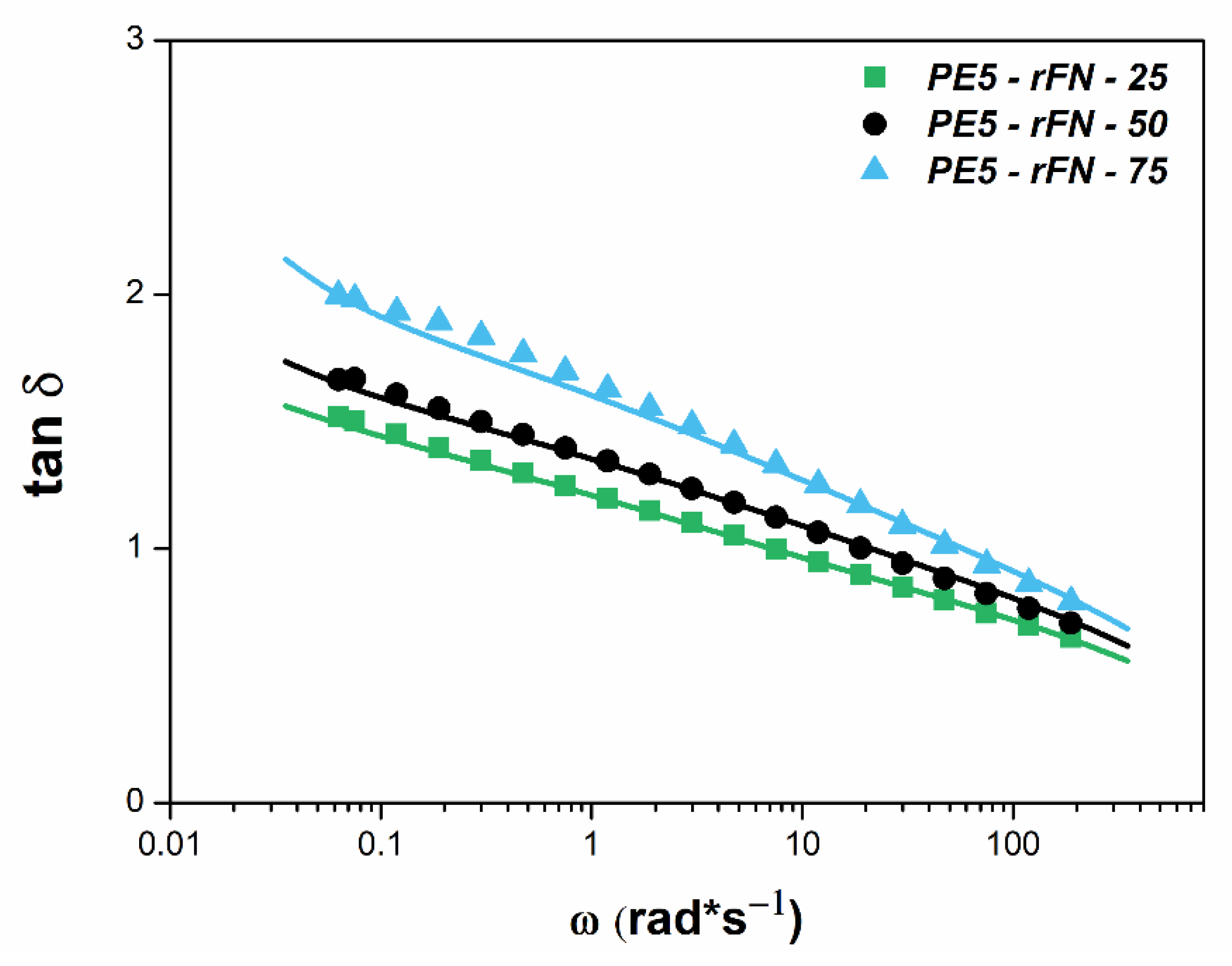
| Material | Type | Mw (kg/mol) | Mw/Mn (−) | SCB/1000C | Tm (°C) |
|---|---|---|---|---|---|
| PE1 | Fibers | 149 | 6.94 | 1.3 | 140.0 |
| PE2 | 146 | 8.42 | 2.1 | 139.5 | |
| PE3 | Packaging | 209 | 29.7 | 0.3 | 132.4 |
| PE4 | 348 | 38.7 | 0.3 | 132.5 | |
| PE5 | 274 | 22.6 | 1.0 | 130.3 | |
| rFN | Recycled HDPE Fishing Net | 121 | 8.40 | 2.5 | 138.0 |
| Blend System | % rFN | Mw (kg/mol) | Mw/Mn (−) | Tm (°C) |
|---|---|---|---|---|
| PE1—rFN | 0 | 149 | 6.94 | 140.0 |
| 10 | 147 | 7.17 | 140.2 | |
| 15 | 144 | 7.19 | 138.8 | |
| 25 | 139 | 7.56 | 137.9 | |
| 50 | 135 | 8.42 | 137.4 | |
| 100 | 121 | 8.40 | 138.0 | |
| PE2—rFN | 0 | 146 | 8.42 | 139.5 |
| 10 | 141 | 8.50 | 138.9 | |
| 15 | 141 | 8.93 | 138.5 | |
| 25 | 138 | 8.68 | 137.9 | |
| 50 | 132 | 9.00 | 138.1 | |
| 100 | 121 | 8.40 | 138.0 |
| Blend System | % rFN | Mw (kg/mol) | Mw/Mn (−) | Tm (°C) |
|---|---|---|---|---|
| PE3—rFN | 0 | 205 | 22.1 | 132.4 |
| 10 | 202 | 20.6 | 133.9 | |
| 15 | 201 | 20.1 | 133.5 | |
| 25 | 193 | 18.9 | 135.9 | |
| 50 | 175 | 15.1 | 136.7 | |
| 75 | 147 | 13.2 | 137.1 | |
| 100 | 121 | 8.40 | 138.0 | |
| PE4—rFN | 0 | 348 | 38.7 | 132.5 |
| 10 | 307 | 34.7 | 133.5 | |
| 15 | 307 | 33.2 | 134.1 | |
| 25 | 286 | 31.7 | 134.8 | |
| 50 | 255 | 27.1 | 135.7 | |
| 75 | 192 | 18.4 | 137.3 | |
| 100 | 121 | 8.40 | 138.0 | |
| PE5—rFN | 0 | 277 | 21.7 | 130.3 |
| 10 | 251 | 19.5 | 131.2 | |
| 15 | 250 | 19.3 | 132.3 | |
| 25 | 240 | 19.7 | 133.9 | |
| 50 | 205 | 15.2 | 135.1 | |
| 75 | 162 | 12.1 | 137.4 | |
| 100 | 121 | 8.40 | 138.0 |
Publisher’s Note: MDPI stays neutral with regard to jurisdictional claims in published maps and institutional affiliations. |
© 2021 by the authors. Licensee MDPI, Basel, Switzerland. This article is an open access article distributed under the terms and conditions of the Creative Commons Attribution (CC BY) license (https://creativecommons.org/licenses/by/4.0/).
Share and Cite
Juan, R.; Domínguez, C.; Robledo, N.; Paredes, B.; Galera, S.; García-Muñoz, R.A. Challenges and Opportunities for Recycled Polyethylene Fishing Nets: Towards a Circular Economy. Polymers 2021, 13, 3155. https://doi.org/10.3390/polym13183155
Juan R, Domínguez C, Robledo N, Paredes B, Galera S, García-Muñoz RA. Challenges and Opportunities for Recycled Polyethylene Fishing Nets: Towards a Circular Economy. Polymers. 2021; 13(18):3155. https://doi.org/10.3390/polym13183155
Chicago/Turabian StyleJuan, Rafael, Carlos Domínguez, Nuria Robledo, Beatriz Paredes, Sara Galera, and Rafael A. García-Muñoz. 2021. "Challenges and Opportunities for Recycled Polyethylene Fishing Nets: Towards a Circular Economy" Polymers 13, no. 18: 3155. https://doi.org/10.3390/polym13183155
APA StyleJuan, R., Domínguez, C., Robledo, N., Paredes, B., Galera, S., & García-Muñoz, R. A. (2021). Challenges and Opportunities for Recycled Polyethylene Fishing Nets: Towards a Circular Economy. Polymers, 13(18), 3155. https://doi.org/10.3390/polym13183155







